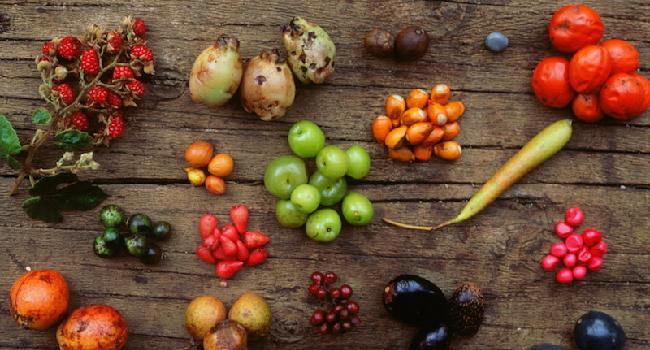
A government inquiry into food security in Australia has been told to transition the agricultural system away from animal production to other uses of the land.
In a submission to the Australian Government inquiry, Vegan Australia has urged the government to encourage a just transition away from the production of animal products towards plant-based agriculture and other uses of the land.
Read the full submission below.
Vegan Australia is pleased to have the opportunity to provide a submission to the Inquiry into food security in Australia by the House of Representatives Standing Committee on Agriculture. We hope this submission assists the committee in recommending actions to address issues with food security in Australia.
Vegan Australia is a national organisation that informs the public about animal rights and veganism and also presents a strong voice for veganism to government, institutions, corporations and the media. Vegan Australia envisions a world where all animals live free from human use and ownership. The foundation of Vegan Australia is justice and compassion, for animals as well as for people and the planet. The first step each of us should take to put this compassion into action is to become vegan and to encourage others to do the same. Veganism is a rejection of the exploitation involved in commodifying and using sentient beings.
Climate change, biodiversity loss and other environmental crises are increasingly threatening reliable and equitable access to food for the world's population.
In this submission Vegan Australia will show that the animal agriculture industry contributes to a number of threats under consideration by this inquiry, including food insecurity and climate change. We will show that the animal agriculture industry also contributes to resource waste, land degradation, water overuse, the decline in the health of ocean ecosystems and an accelerating biodiversity emergency. We will also show that animal agriculture increases the risks of future pandemics and antimicrobial resistance. All of these impact the security of the food supply in Australia.
Vegan Australia recommends that governments encourage a just transition away from the production of animal products towards plant-based agriculture and other land uses.
The submission also shows that meat, dairy and eggs are not necessary for a healthy diet and urges the government to encourage a move towards healthy plant-based diets and to assist the development of new plant-based industries.
This inquiry is an opportunity for the community to reflect on the damaging impact of animal agriculture on many aspects of food security, in particular the damage to the environment and its contribution to biodiversity loss. The extent of the damage is huge, with over half a billion farmed animals bred, raised and killed for food in Australia every year. The animal agriculture industry occupies over half of the Australian landmass, causes the majority of land clearing and emits a significant portion of greenhouse gases.
By acknowledging the impact of animal agriculture on the environment, this inquiry allows us to consider alternative ways we can obtain food and fibre which do not involve both the suffering of farmed animals and the environmental havoc animal agriculture causes.
The key recommendation of this submission is that the government begin a managed phase out of animal agriculture to increase food security and restore damaged ecosystems. Acting quickly and in a controlled way will protect jobs and the economy while also improving access to nutritious food and allowing the environment to recover. A healthy environment is key to food security.
While there are many drivers of the decline in the environment, research shows that the animal agriculture industry is a major contributor to environmental damage in a number of areas. The impact of animal agriculture is often overlooked in inquiries like this and this submission aims to help the inquiry understand how these impacts of animal agriculture increase food insecurity and how they can be addressed.
The havoc caused to the world environment by the billions of animals we breed, raise and kill for food each year is staggering. The United Nations has identified animal agriculture as 'one of the most significant contributors to today's most serious environmental problems', including climate change, species extinction, loss of fresh water, rainforest destruction, spreading deserts, air and water pollution, acid rain, soil erosion and loss of habitat. All of these can contribute to natural disasters that threaten food security in Australia. Vast areas of forest are cleared to grow crops to feed farmed animals. The methane produced by these animals is the largest single cause of global warming, larger than all transport worldwide. Large quantities of excrement produced by animal industries leak into rivers and oceans as pollution.
Fortunately, environmental damage caused by animal agriculture may be the easiest to reduce, because animal products can be replaced by plant products with a much lower environmental footprint.
Instead of growing crops to feed animals who we then eat, it would be much more efficient and cause less harm to the environment if we consumed the plants directly. This would feed five times as many people, make available significant amounts of fresh water, help reverse global warming, use less fossil fuels and allow large areas of land to be reforested.
"Producing meat turns vegetable protein very inefficiently into animal protein, using large amounts of energy and water in the process. Ruminant animals also produce large amounts of methane, a much more potent greenhouse gas than carbon dioxide. Meat production is a serious contribution to greenhouse gas pollution and hence global warming."
- Professor Ian Lowe
Animal agriculture is the leading source of greenhouse gas emissions. We are all concerned about climate change and most people support the move to renewable energy. But many of us are unaware of the catastrophic effect meat, dairy and egg production is having on climate change and other environmental issues. In Australia, animal agriculture emits about 50% of all greenhouse gases, when accounted over 20 years. This is more than all other sources, including energy generation and transport. Animal agriculture produces greenhouse gases through land clearing for grazing, methane produced by cows and sheep, savanna burning for clearing and emissions from manure.
In their greenhouse gas calculations, the IPCC and other international environmental organisations use a Global Warming Potential (GWP) for comparing greenhouse gases using a 100-year time frame. The decision to use a 100-year time frame is arbitrary. The IPCC states that "There is no scientific argument for selecting 100 years compared with other choices. The choice of time horizon is a value judgement." The convention to use a 100-year time frame was decided several decades ago, before the urgent need to avoid climate-system tipping points was understood. Given the urgency of the emissions reductions required to avoid catastrophic temperature increases, a 20-year Global Warming Potential (GWP-20) is much more relevant. Over 20 years, the warming potential of methane is about 5 times higher than over 100 years. Animal agriculture is the largest source of methane and so if we measure the impact of sectors using a 20-year time frame, the climate impact of agriculture is significantly higher.
The IPCC and other groups also ignore the impact of short-term gases on global warming. In the short time we have available to overcome climate change, the Global Warming Potential of these short-lived gases becomes much more significant. Most of these gases are emitted by animal agriculture.
When 20-year GWPs are used and short-term gases are included, we find that animal agriculture is responsible for about 50% of all greenhouse gases, both in Australia and worldwide. For the calculation that animal agriculture is the source of over 50% of Australia's greenhouse gases when accounted over 20 years, see Neglected Transformational Responses: Implications of Excluding Short Lived Emissions and Near Term Projections in Greenhouse Gas Accounting, by Wedderburn-Bisshop, Longmire and Rickards. For the calculation that animal agriculture is the source of over 51% of worldwide greenhouse gases when accounted over 20 years, see Livestock and Climate Change, by Robert Goodland and Jeff Anhang, Worldwatch Institute.
Methane stays in the atmosphere on average about 12 years. This means that reductions in methane emissions will cause more immediate cuts to global warming than reductions in carbon dioxide emissions. Carbon dioxide can stay in the atmosphere for over 100 years, so even if carbon dioxide emissions (from, for example, burning fossil fuels) were reduced now, it would take many decades for this to have an effect on global warming.
Once we understand that animal agriculture is a major source of greenhouse gas emissions, a simple, effective and relatively quick solution becomes clear. By ending the use of animals for food, we not only act ethically for the animals, but also help slow and eventually reverse global warming.
The economic impact of removing animals from the agricultural system will not be as significant as most people believe. The animal agriculture industry is a relatively small part of the modern Australian economy. It currently contributes about 1.2% to the Australian GDP and employs less than 1.5% of the Australian workforce.
If animals were no longer part of the agricultural system, there would be significant positive impacts not just on the climate, but also on other aspects of the environment. Woodlands and forests could be revegetated, marine environments and wildlife habitats could be restored, biodiversity increased, species extinctions reduced, and water use, soil loss and pollution all reduced.
Alongside these benefits, any negative economic impacts could be carefully managed to avoid dislocation, by reskilling workers and reusing land for other purposes. Currently, over half of the Australian continent is used for animal agriculture. Much of this could be used for sequestering carbon which would remove carbon dioxide from the atmosphere and hence start to reverse global warming.
In Australia 54% of the Australian continent is used for animal farming. Most of this is land used for grazing, along with some land used for growing food for farmed animals.
In other words, over half of the Australian landmass is used to produce animals as food, as shown in the large red area of this pie graph.
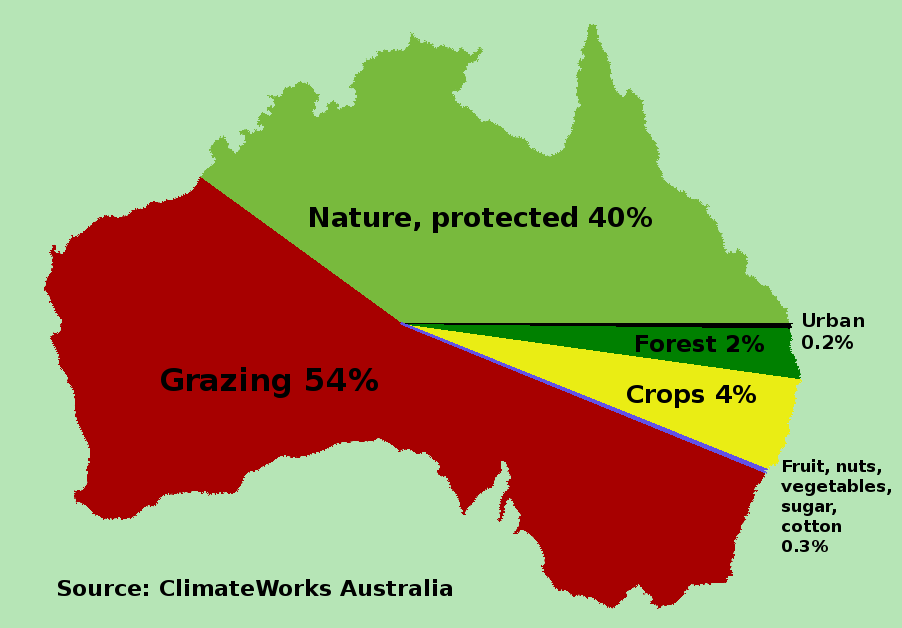
In contrast, only 4% is used to grow crop plant foods, of which about a quarter is used to grow grains and fodder for feeding farmed animals. Fruits, vegetables and nuts use only 0.1%, cotton 0.1% and sugar 0.1%.
The differences are astounding, with a huge amount of land dedicated to raising animals for food, a much smaller part growing crops like wheat and barley, and a tiny amount growing all the fruit and vegetables doctors say we need to eat more of.
As can be seen, growing plants for food is an incredibly efficient use of land.
A key threat to many of Australia's ecosystems and native animals is habitat loss through land clearing, both past and continuing.
A shocking report by WWF-Australia found that millions of native animals are killed each year due to the bulldozing of their forest and woodland habitats. Many die during clearing, crushed by machinery or falling trees. Many others die slowly over days or weeks, from injuries, starvation or exposure. Animals left behind in the cleared landscape are highly exposed and vulnerable to predators.
The report claims that "habitat destruction through tree-clearing probably counts as Queensland's and possibly also Australia's single largest crisis of animal welfare."
Research on soil erosion by the Department of Agriculture in Victoria, found that "under natural conditions, runoff is moderated by vegetation, which generally holds the soil together, protecting it from excessive runoff and direct rainfall." However, excessive clearing, inappropriate land use and compaction of the soil caused by grazing leaves the soil exposed and unable to absorb excess water and leads to erosion, discolouration of water supply and sedimentation of waterways.
To prevent this erosion, the research suggests protecting and re-establishing vegetation, planting trees and "maintaining remnant vegetation along drainage lines and eliminating grazing from these areas."
A report by the Victorian National Parks Association says that "native vegetation is the best way to maintain habitat for threatened plants and animals. Places with remnant native vegetation support a higher diversity of species than areas that have been revegetated."
A report by the CSIRO, states that "Land clearing, primarily for agriculture, is perhaps the single most important cause of environmental degradation, loss of species, and depletion of ecological communities."
Animal agriculture is the key driver for habitat clearing and destruction in Australia. In Australia, the most common land use is grazing animals on modified or irrigated pastures, making up over 50% of the land mass. Additional land is used for growing feed for these animals as well as intensively grown animals.
As the Beyond Zero Emissions Land Use Report says "Since colonisation Australia has seen more biodiversity loss than any other continent and this rate is still one of the highest globally. Deforestation and grazing pressure are the major threats to biodiversity, and cause stress to a range of ecological communities across the continent."
As can be seen from Figure 2.6 of the BZE Land Use Report, much of Australia has been impacted by grazing.
Native vegetation is still being cleared for agriculture in Australia, with about 90% of that used to open up new areas for grazing pasture for animal farming. Queensland is the nation's leader in current land clearing. While NSW is continuing to clear land to some extent, much of the state has already been cleared. For Australia as a whole, agricultural land occupies 53% of the Australian landmass, with 91% of this used for animal agriculture. By comparison about 4% of Australia is used for plant farming, 2% for forestry, 0.4% for urban development and 0.02% for mining.
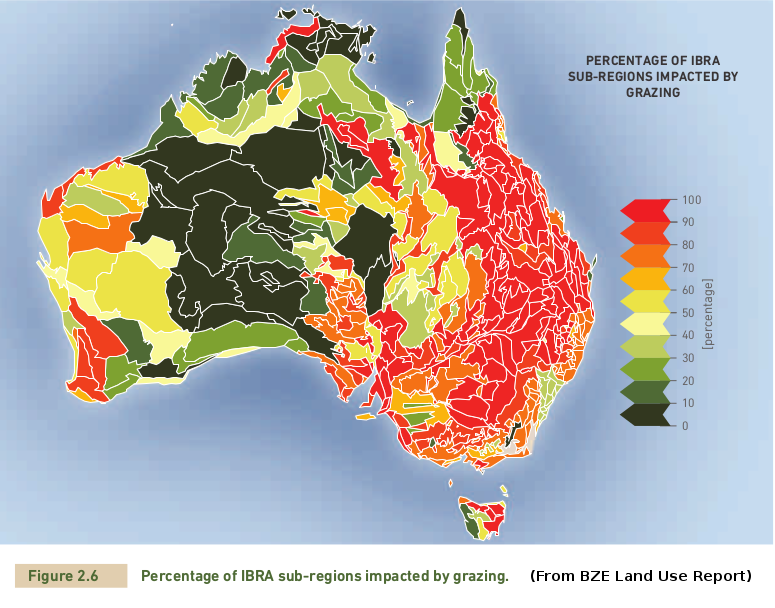
The UN Global Assessment Report on Biodiversity and Ecosystem Services identifies the animal agriculture industry as "one of the most significant contributors to today's most serious environmental problems" including the risk of extinction of one million species worldwide.
The report was released by IPBES, a UN organisation with over 100 member countries, and also found that:
Note that the 18% figure for greenhouse gas emissions from animal agriculture is determined using a 100 year GWP time frame to compare methane and carbon dioxide. Using a 20 year time frame (much more relevant to the current climate emergency), the figure is about 50%. That is, about half of the world's greenhouse gas emissions are due to the animal agriculture industry.
As well as agriculture, the report also lists climate change, pollution and invasive species as damaging to nature, but these have had a relatively low impact compared to the surge in agriculture (mainly animal agriculture) and fishing which are the primary causes of the deterioration.
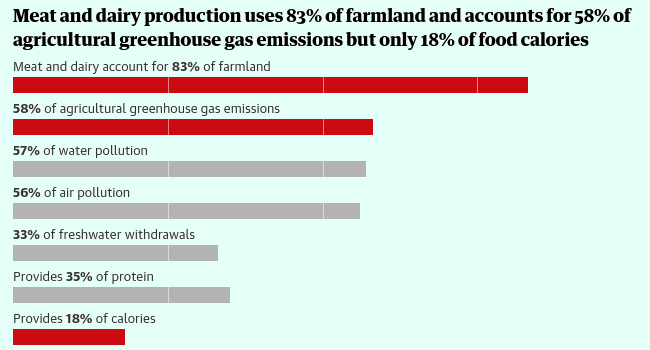
To help reverse some of this damage to the environment, the report recommends that meat consumption be reduced by changes in diet. It suggests that reducing meat consumption in higher-income countries would yield the largest potential gain for the environmental and health benefits.
It suggests "improvements in consumption patterns can likely be achieved by reducing subsidies for animal-based products, increasing those for plant-based foods, and replacing ecologically-inefficient ruminants (e.g., cattle, goats, sheep). Research and development of plant-based meat substitutes is also a growing phenomena and potential solution." It also suggests that meat prices are kept artificially low, which can increase consumption.
The report mentions that another driver for higher meat consumption is its promotion via advertising, which promotes images of identity, such as masculinity and national and cultural identity. "Given the central role of advertising and marketing in boosting production, policies might seek to rein in the reach of advertising, particularly to children and for resource-intensive products" (such as animal products). The report suggests that regulating the advertising of animal products could reduce their consumption and hence improve the sustainability of food.
The report notes that reduced demand for animal products can achieve multiple goals, such as greenhouse gas emission reduction, food security and biodiversity protection.
While the report does not call for a plant-based diet, it does suggest that the less meat, dairy and egg in a diet, the better for the environment and for health. Some scenarios mentioned in the report call for 50% less meat consumption. Regarding the environment, the best future scenario beneficial for biodiversity envisioned by the report includes "a shift in diet towards less meat." It also states that "significant reduction in consumption of meat and eggs means that less agricultural production would be required, thus reducing associated biodiversity loss." Regarding health, the report notes that "diet related disease is the leading cause of premature mortality." and "increased consumption of fruits and vegetables is associated with reductions in various diseases such as cardiovascular disease."
In other words, the report is consistent with Vegan Australia's recommendation to phase out animal agriculture.
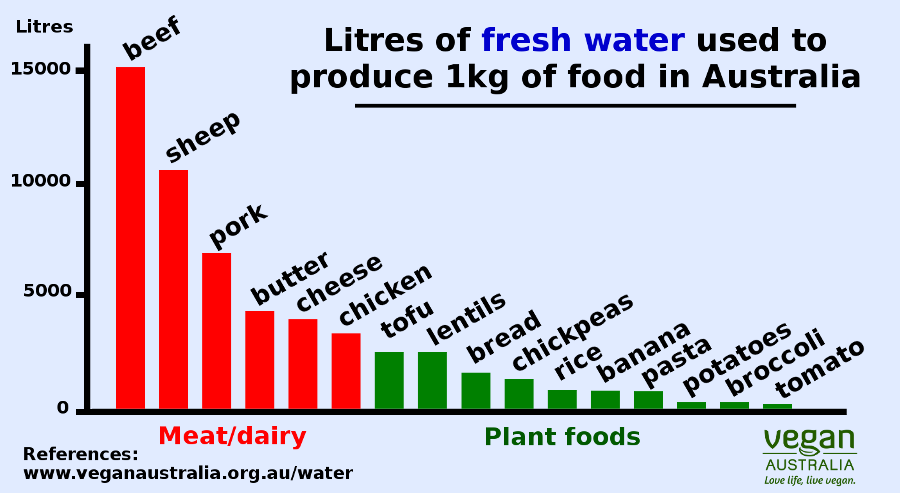
Studies carried out by researchers in Australia and overseas show that over 20 times more fresh water is required to produce animal products compared to the same weight of plant products. Animal agriculture puts a huge strain on our water resources and compromises our water security.
While directly saving water at home is a noble idea, most people don't realise that water used to produce our food makes up 90% of all water used by an average Australian household. So whether saving water for drinking, or saving our mighty rivers and their wetlands, moving to a plant-based diet will have a much more positive impact than having shorter showers or not watering the garden.
As the graph above shows for Australia, producing 1kg of beef, lamb, pork and other animal products takes many more litres of water than 1kg of plant-based foods, like grains, beans, fruit and vegetables.
Some facts about animal agriculture and water use:
More information and references: https://veganaustralia.org.au/water
For decades, hundreds of exotic plant species have been introduced in Australia as feed for animal agriculture and have now become invasive weeds which threaten the environment, cause habitat loss and threaten biodiversity.
One such species is Gamba grass which was originally introduced to Australia as a pasture species for cattle. It is now a significant invasive week in several parts of Australia and increases the frequency and intensity of wildfires and competes with native grasses. See the ABC News article 'Indigenous rangers dismayed as NT Government allows cattle station to graze gamba grass weed'.
By ending animal agriculture, we will not only free up land needed for biodiversity and end the suffering of over half a billion farmed animals every year, but also begin to reverse the damaging impact of invasive pasture grasses.
By removing animals from agriculture, a large proportion of land currently cleared for animal agriculture will be freed up. This will allow regrowth and reforestation which will have many environmental benefits, including strengthening ecosystems, increasing biodiversity and allowing endangered species to recover and possibly preventing extinctions in the future.
Actively revegetating cleared land or allowing it to regenerate naturally will protect soils and prevent erosion, thus producing cleaner water.
Other ways to use the land that will become available when animals are removed from agriculture include:
Carbon farming would enable the land use sector to become a sink for emissions from other sectors, such as power generation and transport.
Only a few possibilities are covered here as this is a large and complex task, with many options and which will require further research. The skilled and knowledgeable rural workforce will be a crucial asset in making this change.
The economic impact of removing animals from the agricultural system will not be as significant as many people imagine. The animal agriculture industry is a relatively small part of the modern Australian economy. It currently contributes about 1.2% to the Australian GDP and employs less than 1.5% of the Australian workforce. Compared to industries like manufacturing (5.9%) and construction (7.7%), the animal agriculture industry is smaller than almost every other industry in Australia. In fact, the only industry smaller than animal agriculture is arts and recreation.
Any negative economic impacts of phasing out animal agriculture should be carefully managed to avoid dislocation, by reskilling workers and reusing land for other purposes, such as carbon farming, biochar production and revegetation as described above. Developing the plant-based alternative industry in Australia will increase and diversify employment opportunities.
As well as the threat to food security from climate change and other environmental damage, it is important that Australia face the issues of the emerging threats of future pandemics and antimicrobial resistance. The risks of each of these threats are increased by the impact of animal agriculture and each could seriously affect food security.
The continuing COVID-19 pandemic was predicted for many years. Scientists from the UN, the WHO, the European Food Safety Authority and elsewhere have been stressing the link between human and animal health for decades. The vast majority of recent emerging or re-emerging infectious diseases have been transmitted from animals to humans. The production of animal foods allows otherwise harmless viruses to mutate and jump from animals to humans and is thus the underlying cause of many infectious diseases.
Most human infections originally came from an animal source. According to the US Centers for Disease Control and Prevention (CDC), 75 percent of new or emerging infectious diseases in people come from animals. Even diseases such as measles, smallpox and tuberculosis originated from the domestication of herd animals. Scientists have been able to determine this by genetic sequencing of the viruses. Even the common cold may have come from domesticated cattle. See Animal origins of human infectious disease, by R A Weiss, University College London. These diseases are known as zoonotic diseases, meaning they are transmitted from animals to people, in most cases through animal agriculture, hunting or other forms of animal exploitation.
Other zoonotic diseases include Coronavirus, Ebola, MERS, Swine Flu, SARS, Bird Flu, Mad Cow Disease, Hendra virus, AIDS and Spanish Flu. These diseases started from human use and exploitation of animals but many are now mainly spread from human to human. Over the last few decades, diseases have originated from animal exploitation industries across the globe: from USA, Mexico, China, United Kingdom, Africa and the Middle East.
Diseases originating from farming, hunting or eating animals have infected billions of people and killed many millions. In addition, the economic cost has been high. In the last few decades, diseases from animal exploitation have cost hundreds of billions of dollars.
The human cost has been even greater for non-European people. Shockingly, livestock-derived zoonotic diseases contributed to the loss of as much as 90% of the native American population. The Australian aboriginal population was similarly impacted by domestic animal-derived diseases brought by European settlers.
A handful of animal species is used to produce the vast majority of animal food products in Australia. Australia can make its food supply chains more secure by not being dependent on industries that are at a high risk of being decimated by disease because of the small number of species concerned. Compare this with the plant farming industry, which grows many hundreds of plant species, and is much less likely to be affected by novel diseases.
We can help prevent the future spread of new, possibly more severe, zoonotic diseases by phasing out the production and consumption of animal products. Governments should recognise the underlying cause of these diseases and take urgent action. We now know that rapid change is possible: the governments of the world reacted within weeks and months of the first case of COVID-19. This proves that governments can act quickly and strongly and they should put the same effort into phasing out animal agriculture and educating the public about alternatives to animal products. We must act now if we are to avoid the "next big one".
The rise of antimicrobial resistance is an emerging threat to Australia, as noted in the National Preventive Health Strategy. In addition, the Fourth Australian report on antimicrobial use and resistance in human health suggests that over 10,000 Australians are likely to die as a result of antimicrobial resistance between 2015 and 2050.
The widespread prophylactic use of critically important antibiotics by the animal agriculture industry is increasing the risk of antibiotic resistance. In Australia, antibiotics are given to farmed chickens (both for egg production and chicken meat production), cattle and pigs. This high use of antibiotics can lead to bacteria evolving to become resistant to the antibiotics. If this new antibiotic-resistant bacteria then crosses the species barrier and infects humans, the infection may not be treatable. Instances of this have occurred around the world, leading to the situation being recognised as a very serious threat to human life.
Australia has among the highest levels of antibiotic use in the world, with well over half of all antibiotics used in Australia being fed to farmed animals. Overcrowded conditions and regular use of antibiotics allow bacteria like E. coli to evolve and become resistant to the same antibiotics we expect to treat humans with.
The US Centers for Disease Control and Prevention, the World Health Organisation, the UK government, and other public health authorities warn that overuse of drugs in animal agriculture are a key generator of antibiotic-resistant pathogens, with warnings going back many decades.
In Australia, farmed animals have been found to be carriers of antibiotic resistant MRSA bacteria and a new antibiotic resistant gene MCR-1 has developed in the worldwide farmed pig population. It is resistant to Colistin, one of our last line of defence drugs against disease. It has been found in pigs across Europe including the UK. Bacteria with this gene have already been found in humans in Australia.
Vegan Australia's recommendation to transition away from the production of animal products implies a change to a plant-based diet for Australians. Nutritional science shows that humans have no need for farmed animal food products. In fact, there is a solid body of peer-reviewed scientific evidence to confirm that it actually benefits human health to consume a primarily plant-based diet. Changing to a plant-based diet can help people live a longer, healthier life, and significantly reduce risk of falling victim to many of the serious health threats facing Australians today.
Australia's peak health body, the National Health and Medical Research Council, recognises that a vegan diet is a viable option for all Australians. Australia's top health experts agree with those in other parts of the world that well-planned vegan diets are safe and healthy for all age groups. The Australian Dietary Guidelines state that alternatives to animal foods, such as nuts, seeds, legumes, beans and tofu, can "increase dietary variety and provide a valuable and affordable source of protein and other nutrients found in meats."
According to the US Academy of Nutrition and Dietetics, "Appropriately planned ... vegan diets are healthful, nutritionally adequate, and may provide health benefits for the prevention and treatment of certain diseases. These diets are appropriate for all stages of the life cycle, including pregnancy, lactation, infancy, childhood, adolescence, older adulthood and for athletes."
The Victorian Government's Better Health Channel states that vegan diets "can provide many health benefits, such as a reduced risk of chronic diseases, including obesity, coronary artery disease, hypertension (high blood pressure), diabetes and some types of cancer". It also states that vegans "have lower rates of illness and death from a number of degenerative diseases" and that vegan diets "are appropriate for all stages of a person's life".
The Final Report of the Independent Expert Panel on Interim Emissions Reduction Targets for Victoria notes that "literature is also emerging to indicate that reduced consumption of meat and of other animal products (which are generally emissions-intensive) can produce health benefits." and acknowledges that "reduced consumption of animal products would provide further health benefits."
Not only are animal products unnecessary for optimal health, an increasing number of nutritionists and health professionals are acknowledging animal products are harmful to our health. This is supported by decades of good research. A healthy vegan diet helps reduce the risk of heart disease, stroke, cancer, obesity, and diabetes, some of Australia's top killers.
A recent issue of the Medical Journal of Australia, dedicated to the question "Is a Vegetarian [including vegan] Diet Adequate?", included the following statements. "A varied and balanced plant-based diet can provide all of the nutrients needed for good health." "Most vegans meet the recommended daily intake for protein." "Vegan diets generally contain just as much or more iron than mixed diets containing meat." "BMI and obesity was lowest for vegans."
The China Study by T Colin Campbell is one of the most comprehensive studies on nutrition ever done. Campbell provides compelling evidence linking animal products to disease, including cancer, heart disease, osteoporosis, diabetes, etc.
By encouraging a transition to a plant-based diet, the Australian Government will not only be responding to the climate emergency, but also aligning these actions with other goals, such as health, industry development and job creation.
Australians themselves are realising the benefits of plant-based diets with research showing that 37% are now actively reducing their meat consumption. The research found that reducing their environmental footprint was the key driver, along with wishing to have a healthier lifestyle and to prevent lifestyle diseases.
Given the damage caused by animal agriculture and the fact that humans do not need animal products to live healthily, Vegan Australia would like to suggest policies the government can adopt to support the transition of the agricultural system away from animal production to other uses of the land.
We urge the Committee to recognise that animal agriculture is a key threat to food security in Australia and to take this into account when making the inquiry's final report. Vegan Australia makes the following recommendations.
Phase out animal agriculture: Vegan Australia has consistently called for the phasing out of animal agriculture. This will allow damaged ecosystems to be restored and biodiversity to improve. The elimination of greenhouse gas emissions from animal agriculture, in conjunction with efforts to substantially reduce fossil fuel emissions, will give us the best chance of avoiding climate-system tipping points and averting the worst effects of climate change. Avoiding the inherent inefficiency of animal agriculture will reduce resource waste and encourage more productive and sustainable methods of producing food. Phasing out animal agriculture will also reduce the risks from the threats of future pandemics and antimicrobial resistance. Finally, a corresponding improvement in diet will lead to a lower risk of many chronic diseases.
Ensure a just transition: The transition to an animal-free agricultural system needs to be managed so that living standards are maintained and there is enough healthy food for everyone. Any negative economic or employment impacts should be minimised and any costs should be borne by the community as a whole. The broader society has an obligation to share the responsibility for this shift, so the burden of the economic costs does not fall solely on rural communities.
Vegan Australia proposes a 10 year phase-out period. This period will allow time for adjustments in employment and investment. We recommend that the government consult with experts and workers to plan a controlled phase out of animal agriculture, carefully managing it to allow the environment to recover while also protecting jobs and the economy.
Changes to land use, such as regrowth and reforestation, will continue far into the future. It is important that these changes be protected. Again the responsibility to manage these risks lies with society both now and in the future and not just with individual landholders.
As with any significant change in the economy, the transition will have real impacts on some individuals, families, communities and businesses. It will be important for the government to build on existing best practice to support impacted communities and ensure a just transition.
Remove subsidies from animal agriculture and give assistance to plant farming: In order to meet this time frame, Vegan Australia recommends the immediate removal of all subsidies currently given to animal agriculture, and the redirection of these funds to plant farming. In particular, transitional assistance should be given to farmers to switch from animal agriculture to other uses of the land, including plant farming, reforesting, habitat protection and carbon farming.
Cease land clearing: A cessation of land clearing would maintain habitat for threatened plants and animals, support biodiversity, reduce erosion and prevent greenhouse gas emissions.
Incentivise tree planting: Tree planting schemes should be encouraged as part of the development of negative emissions technologies. This should include large-scale afforestation and reforestation projects managed by the Australian Government.
Revegetate land currently used for animal agriculture: The revegetation of land would act as a significant carbon sink, as well as improving biodiversity and other markers of environmental health. Some work has been done in this area already, and that that work has the potential to be expanded drastically. See Vegan Australia's research paper "Moving to a vegan agricultural system for Australia". Efforts to sequester carbon by protecting, restoring or regenerating vegetation should be encouraged and supported through access to carbon offsets or government procurement.
Helping endangered ecosystems in this way may have notable social benefits as well. Researchers at ANU have found that landholders who are engaged in environmental programs suffer fewer problems with mental illness.
Include 20-year GWP figures in future climate change publications: In order to ensure that the public, and lawmakers, are properly informed about the true impacts of agriculture (and other industries) the 20-year GWP figures should be included alongside the 100-year GWP figures along with an explanation of how they differ. This is known as "dual term greenhouse gas reporting". This two-value approach, which indicates the effect over two different time horizons, is suggested by a number of studies. Providing the 100-year figures alone, without any explanation of the underlying assumptions used to arrive at this figure, ignores the potentially disastrous effects of climate-system tipping points, and constitutes a failure to properly inform the readers of these documents. To increase transparency, Vegan Australia also recommends that the Australian Government urge other organisations and governments, nationally and internationally, to adopt dual term greenhouse reporting in their publications.
Educate the public about healthy plant-based diets and the damage caused by animal agriculture: The Victorian Government's Independent Expert Panel report on Interim Emissions Reduction Targets for Victoria lists one of the main drivers of greenhouse gas emissions as "rising food demand with beef cattle being the biggest contributor of agriculture emissions, followed by sheep and pigs."
The government needs to act on this evidence to drive down demand. A concerted effort should be made to educate the public about plant-based nutrition and encourage the adoption of healthy plant-based diets. This effort should take a whole of government approach and include community groups such as Vegan Australia. The public should be educated about how consuming animal products can increase the risk of many serious chronic diseases, how to eat healthily on a plant-based diet and the health benefits of a balanced plant-based diet. The Australian Government should also educate the public about the impacts on the environmental (biodiversity loss, land degradation, climate change, etc) of animal agriculture and the ethical aspects of animal use.
The aims of Vegan Australia are to help bring about a world where people respect the rights of animals to their own lives, bodies and freedom and where animals live free from human use and ownership. In this submission we recommend that animal agriculture be recognised as a significant driver of environmental damage and climate change and increases the risks of future pandemics and antimicrobial resistance. We recommend that animal agriculture be phased out to help protect and restore species and ecosystems and to deliver a more secure, just and affordable food system.
Greg McFarlane
Director
Vegan Australia
Unsubscribe at any time. Your details are safe, refer to our privacy policy.
© Vegan Australia | Registered as a non-profit charity by the ACNC | ABN 21 169 219 854